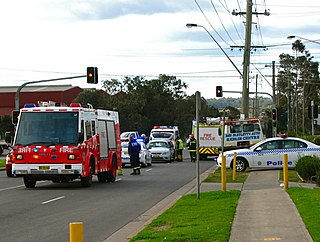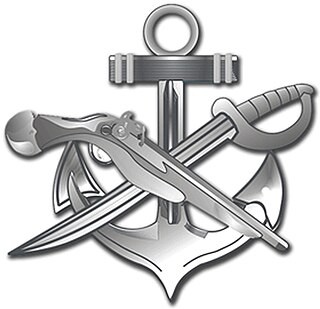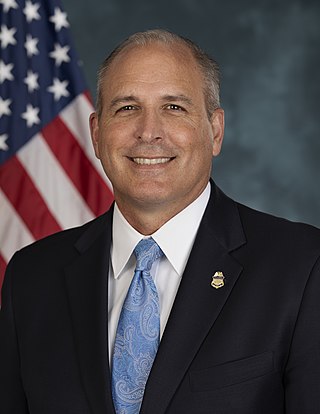
Emergency services and rescue services are organizations that ensure public safety, security, and health by addressing and resolving different emergencies. Some of these agencies exist solely for addressing certain types of emergencies, while others deal with ad hoc emergencies as part of their normal responsibilities. Many of these agencies engage in community awareness and prevention programs to help the public avoid, detect, and report emergencies effectively. Emergency services are often considered first responders, and typically have dedicated emergency vehicles.
U.S. Immigration and Customs Enforcement (ICE) is a federal law enforcement agency under the U.S. Department of Homeland Security. ICE's stated mission is to protect the United States from the cross-border crime and illegal immigration that threaten national security and public safety.

The United States Border Patrol (USBP) is a federal law enforcement agency under the United States Customs and Border Protection (CBP) and is responsible for securing the borders of the United States. According to its web site in 2022, its mission is to "Protect the American people, safeguard our borders, and enhance the nation’s economic prosperity."

United States Customs and Border Protection (CBP) is the largest federal law enforcement agency of the United States Department of Homeland Security. It is the country's primary border control organization, charged with regulating and facilitating international trade, collecting import duties, as well as enforcing U.S. regulations, including trade, customs and immigration. CBP is one of the largest law enforcement agencies in the United States. It has a workforce of more than 45,600 federal agents and officers. It is headquartered in Washington, D.C.

The Alaska State Troopers, officially the Division of Alaska State Troopers (AST), is the state police agency of the U.S. state of Alaska. It is a division of the Alaska Department of Public Safety (DPS). The AST is a full-service law enforcement agency that handles both traffic and criminal law enforcement. The AST is also involved in apprehending fugitives as part of the Alaska Fugitive Task Force, an inter-agency collaborative of Alaska police departments that cooperates with police agencies throughout the United States and less commonly with Interpol in apprehending wanted men and women. Unlike many lower 48 states, the AST also serves as Alaska’s primary environmental law enforcement agency; troopers assigned to the AST’s Division of Alaska Wildlife Troopers are known as "Alaska Wildlife Troopers" and primarily serve as game wardens, although they retain the same powers as other Alaskan state troopers.

Special Tasks and Rescue Group is the Police Tactical Group of the South Australia Police.

A border guard of a country is a national security agency that performs border security. Some of the national border guard agencies also perform coast guard and rescue service duties.

Air and Marine Operations (AMO) is a federal law enforcement component within U.S. Customs and Border Protection (CBP), an agency of the United States Department of Homeland Security (DHS). AMO's mission is to protect the American people and nation's critical infrastructure through the coordinated use of air and marine assets to detect, interdict and prevent acts of terrorism and the unlawful movement of people, illegal drugs, and other contraband toward or across the borders of the United States. Air and Marine Operations Agents and Officers are endowed with the authority to enforce Title 8 and Title 19 (Customs) of the United States Code in addition to the general law enforcement powers bestowed upon federal law enforcement agents.

The Border Patrol Tactical Unit (BORTAC) is the tactical unit of the United States Border Patrol. In 2007, BORTAC was placed under the command of the newly formed Special Operations Group (SOG) together with the Border Patrol Search, Trauma, and Rescue Unit (BORSTAR).
In American law enforcement, the Emergency Service Unit, or ESU, is a multi-faceted element within a law enforcement agency’s Special Operations Command.

Operation Jump Start was a military operation to aid U.S. Customs and Border Protection, announced by President George W. Bush in May 2006. The mission entailed the deployment of United States National Guard troops along the Mexico–United States border for purposes of enforcement of border security and construction of a border fence. The rules of deployment were defined in a memorandum of agreement between officials in the Department of Defense and the governors of Arizona, California, New Mexico, and Texas as well as Mexico.

The Louisiana Department of Wildlife & Fisheries – Enforcement Division (LDWF) is the fish & game regulatory agency of Louisiana. It has jurisdiction anywhere in the state, and in state territorial waters. The agency enforces both state and federal laws dealing with hunting, fishing, and boating safety. The agency also enforces criminal laws in rural areas including DWI enforcement both on highways and waterways. Most of the Department's Wildlife Agents also carry Federal law enforcement commissions issued from the United States Department of the Interior - U.S. Fish and Wildlife Service, and United States Department of Commerce - U.S. National Marine Fisheries Service (NMFS). These federal commissions allow these state officers to enforce federal migratory waterfowl laws and federal marine fisheries laws in state and federal waters off the coast of Louisiana. Besides their traditional role as a "game warden", Louisiana Wildlife Enforcement Agents also have a number of other responsibilities, including conducting board of health inspections on some portions of the state's commercial fishing industry. Agents are trained in and conduct numerous search and rescue operations, both in remote land areas and on the state's waterways. Agents ensure that hunters, anglers, boaters, dealers, breeders, farmers, and transporters are in compliance with regulations governing equipment, quotas, licenses, and registrations. Agents also assist other State departments and law enforcement agencies in the coordination of educational and professional endeavors, as well as national and state emergency alerts by the Federal Office of Emergency Preparedness. In addition, agents perform search and rescue missions alone or in conjunction with other local, state, and federal agencies.

The Special Warfare Combat Crewmen (SWCC ) are United States Naval Special Warfare Command personnel who operate and maintain small craft for special operations missions, particularly those of U.S. Navy SEALs. Their rating is Special Warfare Boat Operator (SB).

The Deployable Specialized Forces (DSF) —formerly Deployable Operations Group— are part of the United States Coast Guard that provide highly equipped, trained and organized deployable specialized forces, to the Coast Guard, United States Department of Homeland Security (DHS), United States Department of Defense (DoD) and inter-agency operational and tactical commanders. The command was formerly headquartered in Arlington, Virginia where it was established on 20 July 2007, and was commanded by a captain. It was decommissioned by the Commandant of the Coast Guard, Admiral Robert Papp on 1 October 2013, with units previously assigned to the DOG being split between Coast Guard Pacific and Atlantic Area commands. The units were subsequently reorganized under Deployable Specialized Forces (DSF).

The Puerto Rico Joint Forces of Rapid Action —Spanish: Fuerzas Unidas de Rapida Acción (FURA)— is an agency within the Puerto Rico Police in charge of specialized divisions that relate to federal law enforcement agencies of the United States, and coordinate operations between the PRPD and U.S. federal agencies. The force is a limited unit, well trained, and well recognized in the police. The force collaborates with law enforcement agencies of the federal government of the United States such as the Federal Bureau of Investigation, the Bureau of Alcohol, Tobacco, Firearms and Explosives, the United States Marshals Service, and the Department of Homeland Security among others.

Mark A. Morgan is an American law enforcement official who served as the Chief Operating Officer and acting Commissioner of U.S. Customs and Border Protection from July 5, 2019, to January 20, 2021.

Carla L. Provost is a retired American government official who served as the Chief of the United States Border Patrol from August 2018 through January 2020. She was the first woman to serve as Chief of the Border Patrol, a career law enforcement position. Provost held numerous positions during her 25-year career in the Border Patrol, including serving as Deputy Chief beginning in October 2016, and Acting Chief from April 2017 until her promotion in August 2018.
The Special Forces and Elite Forces include both a specially and higher trained unit and a small percentage of personnel from a specific Malaysian military branch, law enforcement or government agency. In Malaysia, the term 'Special Forces' is widely used by uniformed services for special forces, special operations forces and 'special' trained units while 'Elite Forces' for units that more trained and capable combat. Regular personnel must undertake specialized and higher training to be able to join the units of the 'Special and Elite Forces'. These "Special Elite Forces" are denoted by different beret colours, shoulder tabs, unit patches, skill badges and uniforms.

















